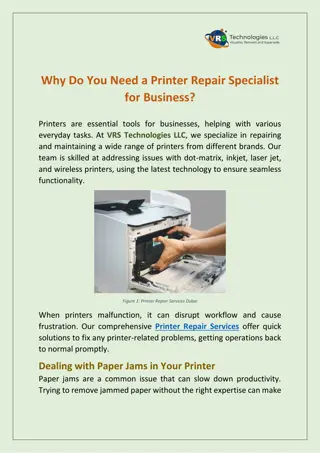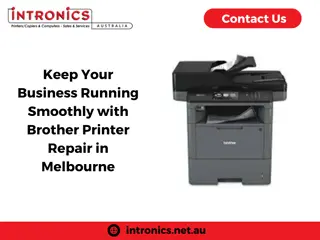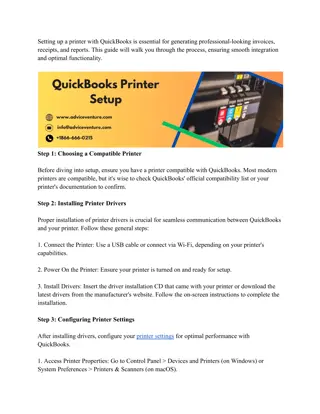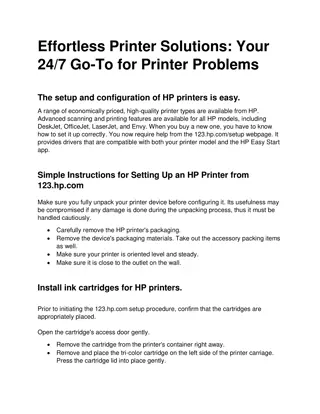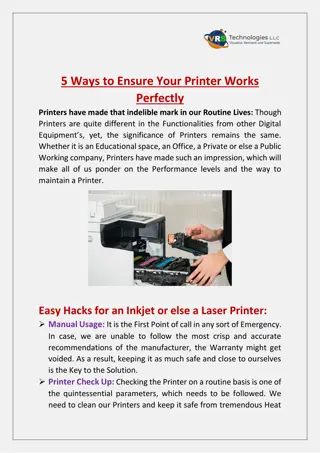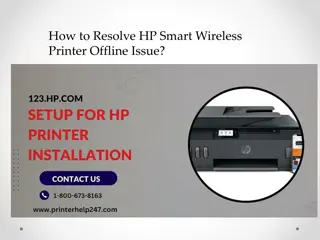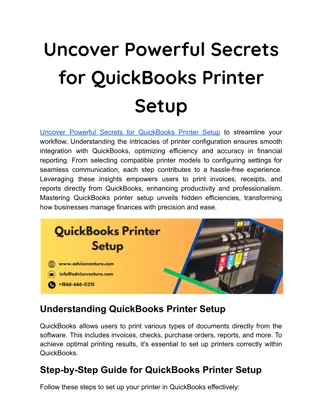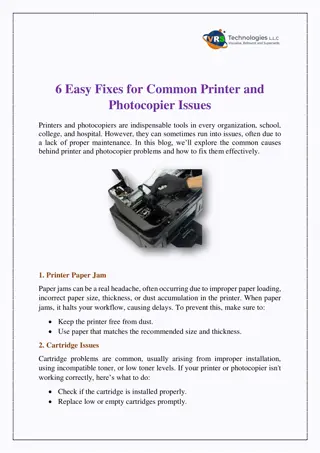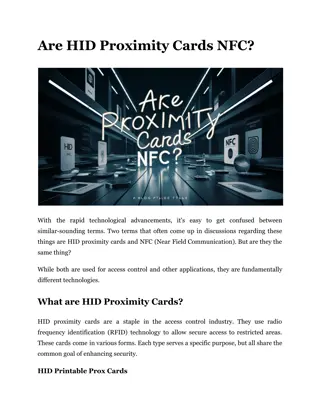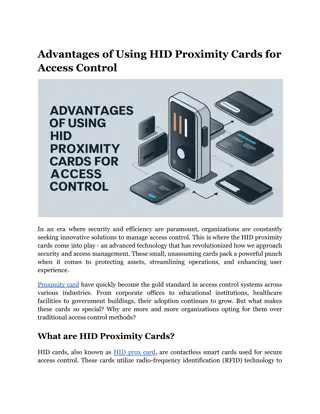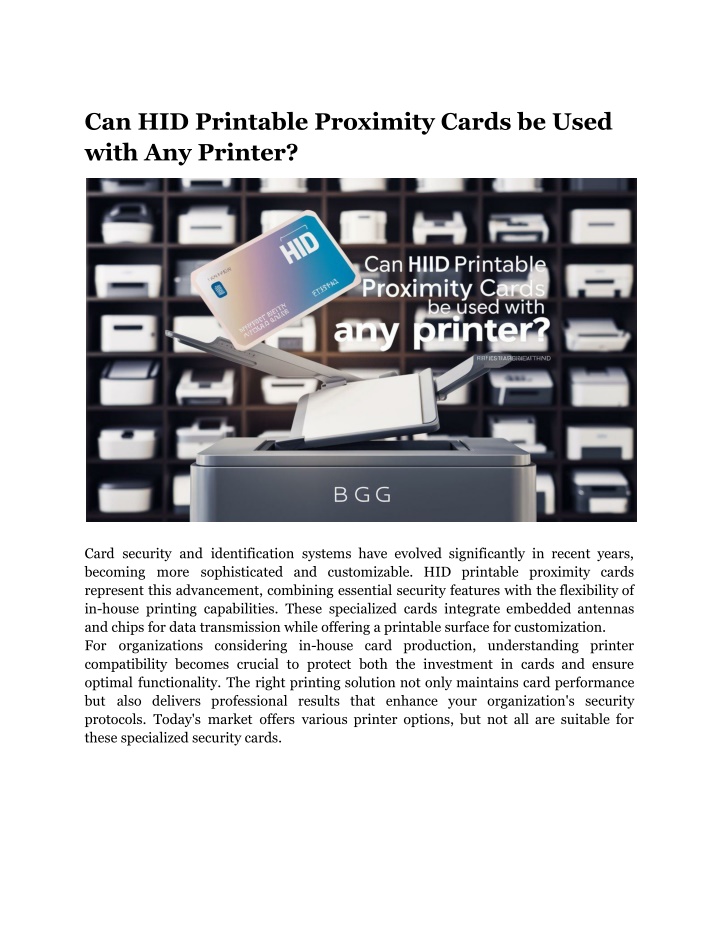
Can HID Printable Proximity Cards be Used with Any Printer_
Wondering if HID proximity cards are compatible with regular printers? Find out the requirements and limitations to make your setup work.
Download Presentation

Please find below an Image/Link to download the presentation.
The content on the website is provided AS IS for your information and personal use only. It may not be sold, licensed, or shared on other websites without obtaining consent from the author. If you encounter any issues during the download, it is possible that the publisher has removed the file from their server.
You are allowed to download the files provided on this website for personal or commercial use, subject to the condition that they are used lawfully. All files are the property of their respective owners.
The content on the website is provided AS IS for your information and personal use only. It may not be sold, licensed, or shared on other websites without obtaining consent from the author.
E N D
Presentation Transcript
Can HID Printable Proximity Cards be Used with Any Printer? Card security and identification systems have evolved significantly in recent years, becoming more sophisticated and customizable. HID printable proximity cards represent this advancement, combining essential security features with the flexibility of in-house printing capabilities. These specialized cards integrate embedded antennas and chips for data transmission while offering a printable surface for customization. For organizations considering in-house card production, understanding printer compatibility becomes crucial to protect both the investment in cards and ensure optimal functionality. The right printing solution not only maintains card performance but also delivers professional results that enhance your organization's security protocols. Today's market offers various printer options, but not all are suitable for these specialized security cards.
Understanding Proximity Card Printing Systems Core Card Technology Proximity ID cards blend advanced electronics with durable materials. The embedded antenna and chip assemblies require specific handling during the printing process to maintain functionality. Modern cards feature multiple protective layers surrounding these components, with an outer PVC surface specifically designed for printing. Understanding this structure helps organizations choose appropriate printing solutions that balance quality with component protection. Key Components: Embedded RFID antenna Protective inner core Data transmission chip Print-receptive surface layer Durability coatings Advanced Printing Systems Professional card printers are divided into two main categories: Direct-to-card (DTC) printers Retransfer printers Each offers distinct advantages for proximity smart card printing. DTC printers provide cost-effective solutions for standard designs, while retransfer technology delivers superior edge-to-edge coverage and enhanced durability. When selecting between these technologies, consider your: Volume requirements Image complexity DTC printers excel in environments with moderate print volumes and basic designs, offering quick turnaround times. Meanwhile, retransfer printers justify their higher cost through exceptional print quality and the ability to handle irregular card surfaces. Temperature Management and Card Protection Heat regulation plays a vital role in printing PVC proximity cards. Modern card printers incorporate sophisticated temperature control systems that protect internal card components while ensuring proper ink adhesion. These systems monitor and adjust heat levels throughout the printing process, preventing damage to sensitive electronic elements. Temperature Considerations: Printhead heat monitoring Gradual warm-up cycles
Cool-down periods Component protection Surface Preparation Professional Print Quality Enterprise-grade printers offer advanced features essential for security credentials. Quality printing ensures your identification cards maintain a professional appearance while resisting wear and tampering. Modern printers incorporate sophisticated imaging systems that produce crisp, clear visuals with consistent color reproduction. Quality Assurance Features: 300+ DPI resolution Color calibration systems Edge-to-edge printing UV-resistant inks Overlay options Maintenance and Care Regular printer maintenance ensures consistent results and extends equipment life, particularly when producing proximity ID cards. A well-maintained printer not only produces superior-quality cards but also prevents costly downtime and repairs. Comprehensive maintenance protocol includes: Systematic cleaning schedules Component inspections Timely updates Organizations can maintain optimal print quality while protecting their investment in printing technology by taking preventive measures like: Weekly printhead cleaning Monthly roller inspections Quarterly deep cleaning Regular software updates Proper maintenance also ensures consistent card encoding reliability. Air quality in the printing environment plays a crucial role in maintaining clean printheads. Staff training in maintenance procedures helps catch potential issues early. Cost-Effective Solutions Choosing the right printing system requires careful evaluation of both immediate and long-term financial considerations. Smart investment decisions balance upfront costs against operational efficiency and output quality. Understanding your organization's specific needs helps avoid overspending on unnecessary features while ensuring all
essential requirements are met. Production volumes often dictate the level of printer sophistication needed. Regular cost analysis helps maintain budget alignment while meeting quality standards. Consider these factors when selecting a printing system: Production volume requirements Initial equipment investment Ongoing maintenance costs Consumable expenses Training requirements Security Enhancement Options Modern card printers support various security features, especially when producing a proximity smart card. Today's advanced protection options combine multiple layers of security, from holographic overlays and micro-text printing to UV ink layers. Smart chip encoding adds another dimension of security Biometric integration offers the highest level of access control These sophisticated features work together to create a comprehensive security solution that prevents unauthorized duplication while maintaining the card's functionality. Card Design Integration Creating effective designs for PVC proximity cards requires a perfect balance of security features and visual appeal. Professional card designs must account for brand requirements while strategically placing security elements. Every design element, from text placement to color schemes and logo positioning, must work together to create secure yet visually appealing credentials. Design experts understand the technical limitations and opportunities of card printing technology, ensuring each design maximizes both security and aesthetic impact. Custom design elements can include: High-resolution graphics Precise color matching Strategic placement of security features Storage and Environmental Factors Maintaining card integrity starts with proper storage conditions and handling protocols. Environmental factors play a crucial role in preserving card functionality and print quality. Good storage solutions protect your investment while ensuring cards remain in optimal condition. Temperature fluctuations and humidity can significantly impact card performance. Professional storage systems help maintain consistent environmental conditions. Storage Guidelines:
Temperature control Humidity monitoring Light exposure limitation Static prevention Handling procedures Enterprise Implementation Successful implementation. Having clear protocols and trained staff ensures smooth operation across your business. Regular assessments help identify potential issues before they impact operations. Quality control measures maintain consistent output standards. Professional training programs create confident, competent teams. Large-scale deployment requires: Staff training programs Quality control processes Backup system planning Maintenance schedules Security Protocols large-scale card deployment demands a structured approach to Future-Proofing Your Investment When investing in HID printable proximity cards, consider the long-term sustainability of your solution. Technology evolves rapidly, making scalability and upgrade potential crucial factors. Your investment should: Accommodate future expansion Integrate with emerging technologies, Include reliable support options Understanding warranty coverage and upgrade paths helps protect your investment while ensuring your system remains current with security standards. Regular software updates and hardware maintenance plans keep your system operating at peak efficiency. Quality Validation & Testing Every printed card undergoes rigorous quality testing to ensure both visual and functional excellence. Multiple test phases verify card performance under various conditions. Industry-standard testing measurements. Testing Protocols: Print quality assessment Encoding verification Durability testing equipment provides objective quality
Signal strength validation Custom Programming Options Modern access cards offer extensive programming flexibility to meet specific security requirements. Custom data structures can accommodate unique organizational needs while maintaining compatibility with standard systems. Professional programming tools ensure accurate data encoding and secure information storage. Regular updates allow for security protocol adjustments as needs evolve. Programming capabilities extend to multi-application support, ensuring your cards can serve multiple functions while maintaining the highest security standards. Each programming solution is tailored to your specific requirements, with built-in flexibility for future modifications and enhancements. The Bottom Line Selecting the right printing solution for HID printable proximity cards requires careful consideration of multiple factors, from printer compatibility and maintenance requirements to security features and long-term scalability. While not every printer is suitable for these specialized cards, organizations that invest in appropriate technology, implement proper maintenance protocols, and follow recommended storage and handling procedures can successfully produce high-quality, secure identification credentials in-house. At Bristol ID Technologies, we revolutionize secure identification through innovative card solutions. Our cutting-edge printing systems and premium materials guarantee exceptional quality for every credential produced. Three decades of expertise power our commitment to delivering durable, secure, and professionally designed identification solutions. Let our specialists guide you through enhancing your security infrastructure with state-of-the-art ID technology because your security deserves nothing less than excellence. Site Article: Can HID Printable Proximity Cards be Used with Any Printer?




